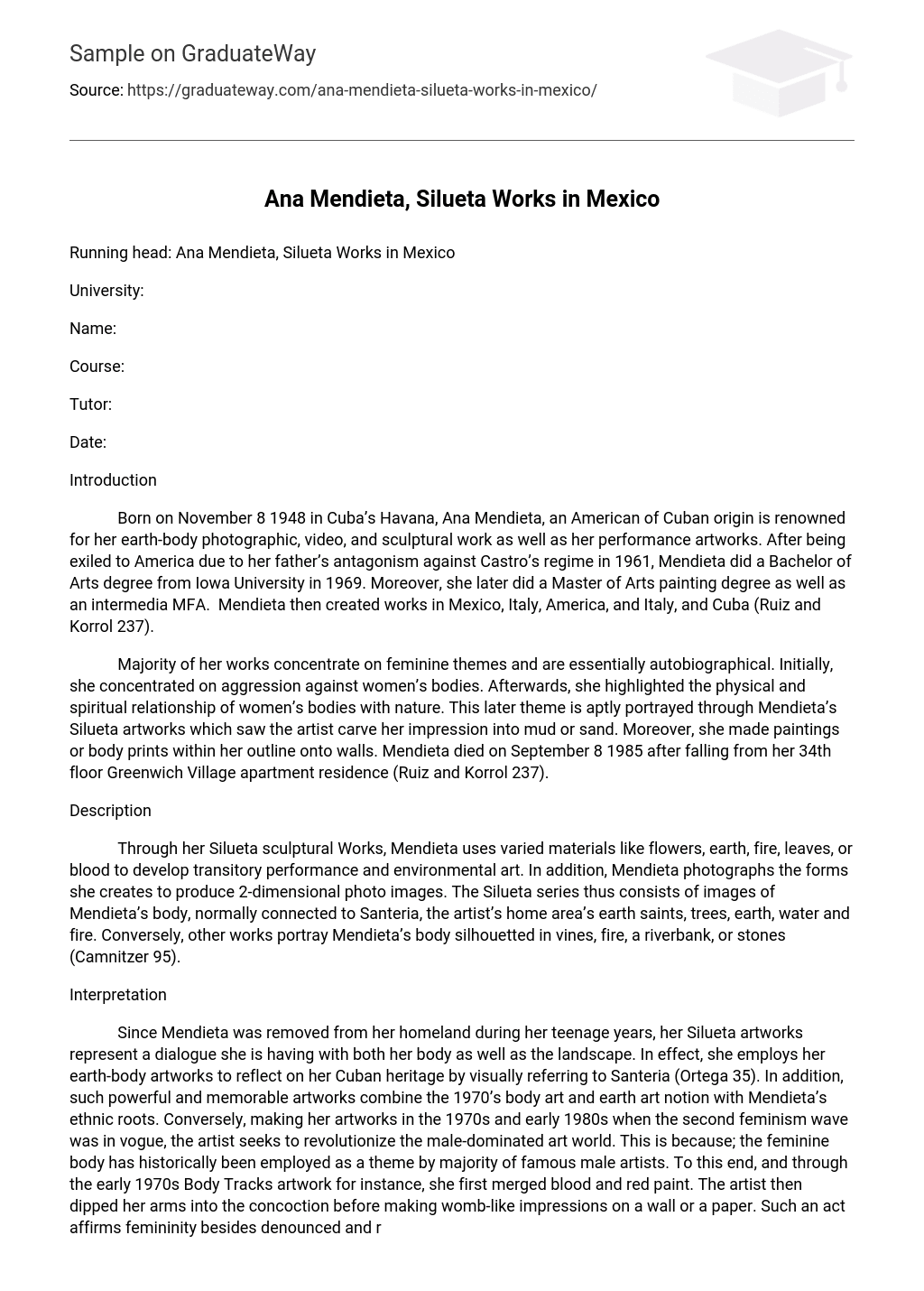Introduction
Born on November 8 1948 in Cuba’s Havana, Ana Mendieta, an American of Cuban origin is renowned for her earth-body photographic, video, and sculptural work as well as her performance artworks. After being exiled to America due to her father’s antagonism against Castro’s regime in 1961, Mendieta did a Bachelor of Arts degree from Iowa University in 1969. Moreover, she later did a Master of Arts painting degree as well as an intermedia MFA. Mendieta then created works in Mexico, Italy, America, and Italy, and Cuba (Ruiz and Korrol 237).
Majority of her works concentrate on feminine themes and are essentially autobiographical. Initially, she concentrated on aggression against women’s bodies. Afterwards, she highlighted the physical and spiritual relationship of women’s bodies with nature. This later theme is aptly portrayed through Mendieta’s Silueta artworks which saw the artist carve her impression into mud or sand. Moreover, she made paintings or body prints within her outline onto walls. Mendieta died on September 8 1985 after falling from her 34th floor Greenwich Village apartment residence (Ruiz and Korrol 237).
Description
Through her Silueta sculptural Works, Mendieta uses varied materials like flowers, earth, fire, leaves, or blood to develop transitory performance and environmental art. In addition, Mendieta photographs the forms she creates to produce 2-dimensional photo images. The Silueta series thus consists of images of Mendieta’s body, normally connected to Santeria, the artist’s home area’s earth saints, trees, earth, water and fire. Conversely, other works portray Mendieta’s body silhouetted in vines, fire, a riverbank, or stones (Camnitzer 95).
Interpretation
Since Mendieta was removed from her homeland during her teenage years, her Silueta artworks represent a dialogue she is having with both her body as well as the landscape. In effect, she employs her earth-body artworks to reflect on her Cuban heritage by visually referring to Santeria (Ortega 35).
In addition, such powerful and memorable artworks combine the 1970’s body art and earth art notion with Mendieta’s ethnic roots. Conversely, making her artworks in the 1970s and early 1980s when the second feminism wave was in vogue, the artist seeks to revolutionize the male-dominated art world. This is because; the feminine body has historically been employed as a theme by majority of famous male artists. To this end, and through the early 1970s Body Tracks artwork for instance, she first merged blood and red paint. The artist then dipped her arms into the concoction before making womb-like impressions on a wall or a paper. Such an act affirms femininity besides denounced and references the prevailing sexist masculine settings (Des Moines Art Center).
On the contrary, Mendieta merges her nude body with natural sceneries to show that art does not always have to serve to affirm the ego of the artist (Gopnik). In other words, Mendieta argues that the development of artworks is not an unconcealed action through which artist captures and conveys truth or beauty. Instead, she holds that the making of artworks enables artists to imprint their egos onto the world. The 1970s Body Tracks piece clearly illustrates this concept.
Conclusion
In conclusion, Mendieta was a renowned body-art artist whose works set the stage for women to foray into art. Having been forcibly removed from her Cuban homeland when she was a teenager, the artist uses her Silueta artworks to pay homage to both her feminine self as well as her home country. By concentrating on female bodies, Mendieta seeks to do challenge the prevailing male-domination of art thus being in tandem with the second feminisms movement.
Works Cited
- Camnitzer, Luis. New art of Cuba. Austin, Texas: University of Texas Press, 2003.
- Gopnik, Blake. Silueta’ of a Woman: Sizing up Ana Mendieta. 17 Oct. 2004. 19 May 2010. <http://www.washingtonpost.com/wp-dyn/articles/A35164-2004Oct15.html>.
- Ortega, Mariana. “Exiled Space, In-Between Space: Existential Spatiality in Ana Mendieta’s Siluetas Series.” Philosophy and Geography 7. 1 (2004): 25 – 41.
- Ruiz, Vicki and Korrol, Virginia Sanchez. Latina Legacies: Identity, Biography, and Community. Oxford, UK: Oxford University Press US, 2005.





